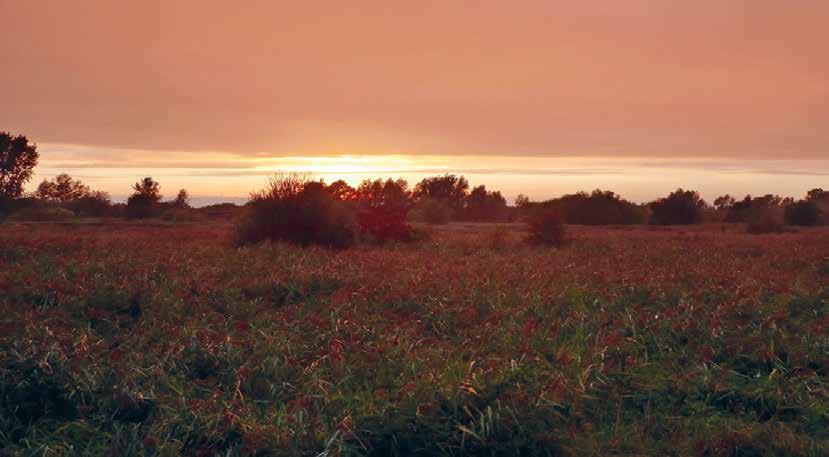
10 minute read
Fowlmere RSPB Nature Reserve
Nature
Fowlmere RSPB Nature Reserve
Advertisement
The reserve at dusk
Once again there have been some interesting sightings at the reserve and in this article, local birder Ade Cooper sets out his diary for the months of August, September and October. August – a new month and some great news! Spotted Flycatchers had been very elusive this year and I had not been able to confirm any breeding, so I was delighted to see 2 adults feeding 3 fledged young around the loop in the centenary end. At the same time, a Nuthatch put in an appearance.
The Marsh Harriers were still present, although it was likely they would disperse very soon. There were many young birds calling, especially newly fledged Reed Warblers, who seemed to be all around the reserve, and several young Water Rails.
Juvenile Reed Warbler just fledged Water Vole
The Spring hide was the most entertaining place for viewing. A Water Vole made regular appearances from the small island in front of it, and a juvenile Kingfisher was also using the pool regularly. An adult Water Rail could often be seen on the right-hand side of the pool, underneath the trees and just tucked into the reeds.
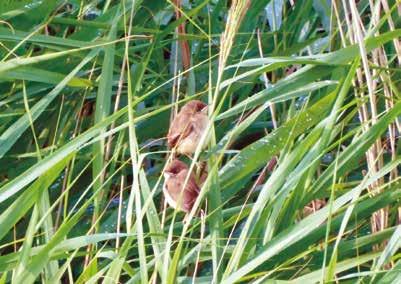
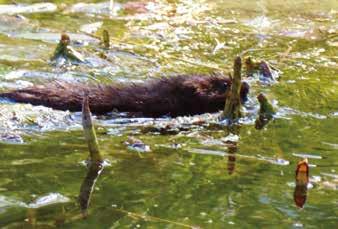
Kingfisher

On the 12th there was another Spotted Flycatcher family around the hide. On this day I also saw the pair at the centenary end, so I could confirm two successful pairs at the reserve – excellent!

Spotted Flycatcher. Adult flanked by juveniles
There was less activity at the Reedbed hide: visitors reported a Hobby hunting dragonflies over the mere and a Green Sandpiper dropping in briefly but realising that the water level was too deep for it to feed. Happily, the water was now dropping and a mud edge was just about visible.
As expected, the Marsh Harriers had by then dispersed away from the reserve. A Willow Emerald Damselfly was around the pond dipping pools along the boardwalk.
By mid-month there was a definite feel of Autumn in the air. Yellow Wagtails had begun going over, Lesser Whitethroats were feeding on elder berries and a presumed passage Garden Warbler had been seen – all firm signs of Autumn.
The Spotted Flycatcher family were still there around the loop in the centenary end, and several butterfly species could be seen, with Brown Argus, Common Blue and Small Copper being the best. There were a number of Tortoiseshells on the wing, but still very few Gatekeepers. The year overall had not been good for butterflies at Fowlmere, with numbers well down.
An Otter was reported by a visitor at the Spring hide on the 15th.
By the 20th water levels at the mere had fallen further and a decent strip of mud was showing at the edge; we were pleased then to see a young Greenshank arrive, staying throughout the following day. I hoped this was the first of a few wader species in the coming weeks.
In the early morning on the 21st the car park was buzzing with Chiffchaffs, Whitethroats, Blackcaps, Goldcrests, Treecreepers, and the Spotted Flycatchers,

Juvenile Greenshank all feeding in the hawthorn, elder and ash. Lesser Whitethroats were on the Guilden brook and there was just one yellow juvenile Willow Warbler.
A number of predator birds were seen, including Peregrine Falcons, Hobbies, Kestrels, Red Kites, Buzzards and Sparrowhawks, and our male Marsh Harrier surprised us by making a brief reappearance on the 22nd, flying into the nest site at around 17.00 and then out north again at 19.45.
Wildfowl on the mere were now increasing, with new Teals, Water Rails, Little Egrets and a count of 52 Mallards. By the end of the month the Teal count was up to 10 and there were also 27 Moorhens. 2–3 Kingfishers were frequently seen, and the first autumn Snipe was back on the mere edge.
One late evening saw a pre-migration build-up of at least 50 Swallows, and 40 Linnets were briefly around the mere looking for a drink.
A secondary feather of a juvenile Cuckoo found on the path by the Shep was interesting. A Cuckoo raised on the reserve would be great news, but this one may have been short-lived since a juvenile Cuckoo should not be losing its feathers. There was just one feather, so possibly it had a close call and got away: I like to think so!
By the end of the month gulls were gathering. A field being ploughed on the east side had 150+ Lesser BlackBacked Gull following it, 2 Herring Gulls mixed in and the first Common Gull of the autumn. 2 Hobbies were seen high above the reserve and then another over the field with the gulls. While watching the gulls, 2 Golden Plovers came flying in and then departed; these were also the first of the autumn.
On the 29th, a Great-White Egret was feeding around the mere for about half an hour before flying eastward. The first confirmed breeding in Cambridgeshire took place this season and Great-Whites are now very easy

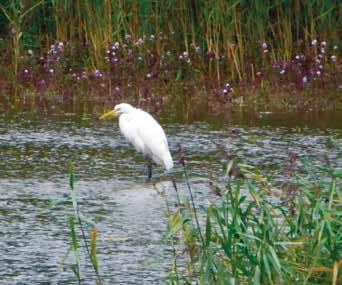
Great-White Egret to find along the washes, but are still scarce here in the south of the county. I saw one flying over the reserve earlier in the year, but seeing one feeding on the mere at close range was much better!
Interestingly, a visitor reported seeing (and photographed) a female Smew in front of Drewer’s hide in the afternoon of the 29th. This bird was undoubtedly an escape, probably from the Dernford collection where there are at least four.
Early in September I was pleased to find a Whinchat on the Guilden brook, and then soon after a Redstart in the same hedgerow. Both sightings were brief, with the Whinchat flying away over the fields and the Redstart moving quickly into cover after just a few moments.
Warbler numbers had naturally dwindled as the birds moved out, but all the commoner species except Willow Warblers were still present. I was particularly pleased to see a Grasshopper Warbler fly up from cover. An adult Peregrine flew over northwards and a Hobby was seen feeding very high up over the reserve. A really good flyover was a calling Ringed Plover on the 4th: this is only the 9th record for the reserve.
The mere was very lively with a good number of birds using the area. Teals were coming in, reaching 45 on the 5th and 30 Moorhens were counted. Other species seen around the mere included Little Egrets, Kingfishers, a group of Swallows and a Sand Martin. Grey Wagtails and Water Rails were creeping around the fringes. A juvenile Tufted Duck flew in late on the 5th, a species we haven’t had many of this year, and a Great White Egret was reported to have been seen.
Two Tawny Owls were heard calling in the middle of the day. Butterfly numbers were then declining, but warm, sunny weather on the 5th brought large numbers out. A brilliant record for the reserve was a Clouded Yellow, which flew along and away down the Guilden brook. This is only the second record for Fowlmere that I know of. Several other species were seen: Small Copper, Small Heath, Common Blue, Peacock, Small White, Meadow Brown, Speckled Wood and Red Admiral.
Willow Emerald Damselflies were out at the Spring hide and along the boardwalk. Only one mating pair could be found at Spring hide, they were certainly not as numerous as last year. A few were seen there again a week later, and I also found a pair at the old Cress Hut, a place I haven’t seen them before.
By the middle of the month the Moorhen count had reached 41, while Teal numbers had reduced to around 30. Little Egrets and Kingfishers were almost permanently around the mere. Ravens, Marsh Harriers, Peregrine Falcons, Hobbies and Grey Wagtails were all recorded as seen. Early on the 15th Meadow Pipits and Siskins were noted going through for the first time this Autumn.
The Thursday volunteer work party had the best sighting at that time, discovering Small Red Eyed Damselflies on the mere, at least 11 of them. This is the very first record for the reserve, excellent!
Small Red Eyed Damselfly..first reserve record

The small numbers of migrating birds noted at this time were a worrying indicator of declining bird populations. For example: not a single Yellow Wagtail had been seen flying over and just one flock of 5 Lapwings – quite alarming.
A group of 4 Wigeons flew into the mere on the 18th and a calling Green Sandpiper flew over on the 19th. We also saw groups of Meadow Pipits, Swallows, Mistle Thrushes and a single Sand Martin, all heading south.
By the final week of September most of the summer residents had moved out. The only warblers remaining on site were a few Chiffchaffs and Blackcaps. Visible migration was again very limited: small numbers of Meadow Pipits and Skylarks going over, a Grey Wagtail and a Siskin. Jays were also on the move, with high flying groups of 3 and 7 passing through.
On the mere, a young male Shoveler spent the 25th mostly asleep, accompanied by 40 Teals, 60 Mallards, a Snipe, 2 Little Egrets and the usual Kingfisher.
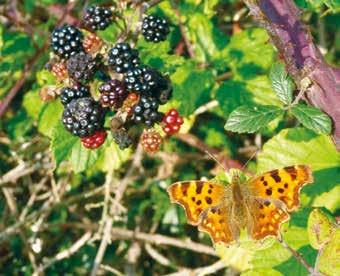
More than usual numbers of lovely fresh Comma out on the wing.
A single Raven was seen flying over the reserve on two days and there were good views of a Barn Owl at dusk when one perched on the window of the Reedbed hide while I was sitting 10 feet away. I don’t know who got the bigger shock!
In mid-October, the Redwings started to make an appearance; initially all went straight through, but later groups could be seen in the early morning stopping for short periods to feed before moving on southward.
Virtually all the summer visitors had by then departed. Black-Headed Gulls were coming into rest, up to 50-60 at times, along with a few Lesser Black-Backs, and Herring Gulls and Yellow-Legged Gulls could be seen with them in the field off the centenary end.
There had been few Otter sightings this year so 3 in the mere on one day was a good record.
Later in the month a Green Sandpiper was seen on two days feeding on the mere edge: only the 5th record


What to do for entertainment when its a bit quiet … watch fighting Bee’s! These two were in the water for a good 5 minutes. The pond skaters also found it fascinating and looked like they were egging the Bee’s on. At the end of it both Bee’s flew off, which was surprising! of the year which is fairly poor. One Chiffchaff and one Blackcap were still on site, and a large flock of Siskins and Goldfinches was in the alders. Flying overhead were a Redpoll, a Raven, 8 Golden Plovers and a single flock of 25 Skylarks.
It was great to see the Starlings back! Around 1000 were roosting in the final week, with more expected as birds come in from the continent. Hopefully the numbers will match those seen last year.

The Starlings are back This article is a synopsis taken from the website produced by Ade Cooper and Caroline Scott about Fowlmere Bird Reserve. To see the full version and other interesting visits Ade and Caroline have undertaken in the UK and abroad, visit: www.cooperandscott.wordpress.com










